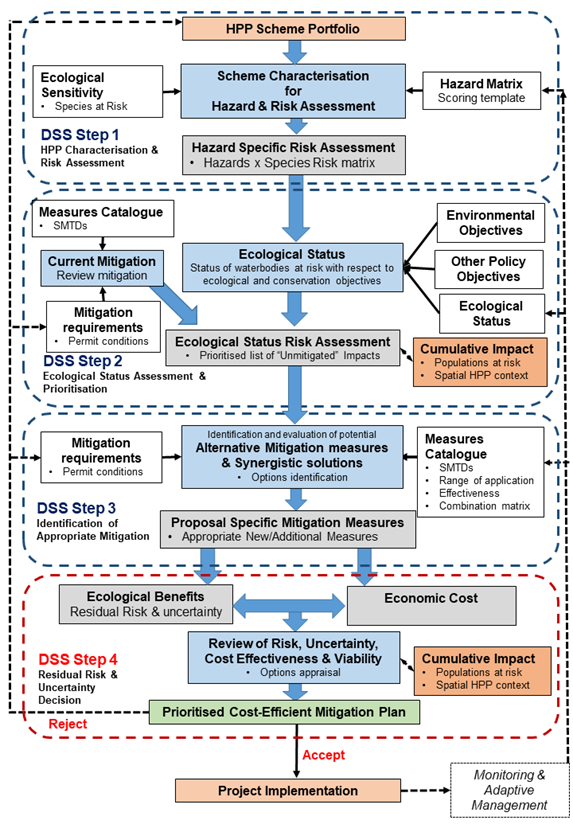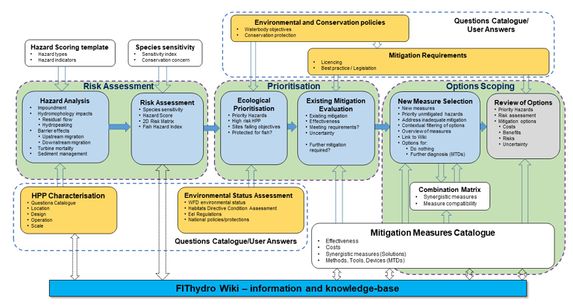Decision support system
This article provides general information about the Decision Support System. For more information about the application of the DSS, see DSS steps.
The DSS can be accessed at https://www.dss.fithydro.wb.bgu.tum.de/home/ui.
Contents
Background

The proliferation of hydropower development to meet obligations under the Renewable Energy Directive has also seen the emergence of a conflict between the hydropower developers and the fisheries and conservation sectors. The hydropower industry wants a joined up response to their planned developments with sound guidance and timely decision-making. On the other hand, the fisheries and conservation interests have concerns over the impact that these schemes can have (especially the impact on WFD and Habitats Directive status) and want to be fully consulted on proposed schemes. As a result, there is a need to develop robust and transparent, evidence-based, support for decision making that is easy for developers and regulators to use while enabling a high level of appropriate environmental protection and mitigation.
Whilst many guidelines exist for assessing the sustainability of hydropower schemes or the need for retrofitting existing structures, they are often limited in their assessment of risks and uncertainty about the impact of schemes on fisheries and the environment. Few provide support for the decision-making process at each stage of evaluation. At each stage of the process, decisions have to be made about the acceptability of the risks and uncertainty of impacts of hydropower schemes, and the ability to manage those risks.
Decision Framework
The FIThydro Decision Support System (DSS) is based on a planning and decision framework comprising a sequence of four key steps, each encompassing a series of key considerations and decisions. The framework enables operators and regulators to develop structured proposals for new HPP schemes, and to both, review and risk assess, those proposals whilst identifying appropriate mitigation measures to address the impact of both new and existing HPP schemes. The framework leads the decision maker through four key steps which act to characterize, risk-assess (and prioritize) the scheme(s) together with the identification of the most appropriate and potentially cost-effective mitigation options addressing the hazards and impacts arising due to the nature and context of the specific scheme(s).
The FIThydro planning and decision framework comprises a sequence of four key steps, each encompassing a series of key considerations and decisions. The framework enables operators and regulators to develop structured proposals for new schemes, review and risk assess those proposals and, additionally, identify appropriate mitigation measures to address the impact of an existing scheme or portfolio of existing schemes within a particular catchment or member state. The framework leads the decision maker through four key steps which act to characterize, risk-assess (and prioritize) the scheme(s) together with the identification of the most appropriate and potentially cost-effective mitigation scenario addressing the pressures and impacts arising due to the nature and context of the specific scheme(s). The four key planning steps are as follows:
- Step 1 Pre-screening characterization, hazard identification & risk assessment
- Step 2 Ecological status assessment and review of existing mitigation
- Step 3 Identification of appropriate mitigation measures and synergistic solutions
- Step 4 Risk-based decision of scheme plan OR Scoping of detailed cost-efficient mitigation plan
These four steps lead decision makers from simple characterization of a scheme and determination of its spatial and policy context, through a risk-based identification of hazards and impacts on sensitive fish species to identification of the most appropriate mitigation scenarios. The decision process leads ultimately to a structured assessment of the acceptability of a proposed scheme or scoping the measures required for mitigating existing hydropower plants, with associated risks and uncertainty.
Web tool implementation
The final FIThydro decision-support web-tool is based on the project management approach and outlines the steps that should be undertaken for the initial screening of a project to appraise the impacts, risks and scope options for further diagnosis and mitigation. Question catalogues, risk assessments and filtering tools are produced which cover aspects of ‘initial screening’, ‘ecological impacts’, ‘environmental status’, ‘mitigation measures’, and ‘risk and uncertainty’. Taken together, these aid the production of a project screening/scoping report designed to provide a systematic approach to decision-making for proposals relating to hydropower schemes and their mitigation. The DSS is presented in the form of an open access web-based tool which utilizes and showcases some of the tools and outputs produced by the FIThydro project.
Conceptual workflow diagram of the Decision Support System web-tool – highlighting key steps (green), tasks/processes (blue), user inputs (yellow), system inputs/knowledge (white) and outputs (grey) – key questions and concepts are noted for each step.
Users/Uses
The FIThydro DSS web tool is aimed at regulators, engineering consultants, developers and operators and orientated around a single, risk-based, planning structure for scoping of mitigation plans for hydropower in relation to the impacts on fish populations. The planning and decision framework is designed to be sufficiently flexible to address decision making in two similar but contrasting scenarios (use cases):
- impact assessment and planning of new mitigation measures for existing HPPs.
- planning and risk assessment of a new HPP scheme proposal.
Scope
Impacts considered
Three main modes of impacts of the operation of hydropower on fish and the riverine environment have been identified (Harby et al., 2019):
- Direct impacts on fish (e.g. impingement/entrainment and turbine mortality/injury)
- Barrier effects (barriers to fish passage and sediment dynamics)
- Habitat alteration/loss effects (impoundment, loss of free flowing river reaches and/or reduced/regulated flows downstream of turbines – including hydropeaking).
The list of, for the most part discreet, hazards that are applicable to all hydropower operations comprises:
- Hydromorphology Upstream – the effects of the impoundment and loss of lotic habitats
- Hydromorphology Downstream – alteration to flows and substrate (as influenced by the effect of the barrier on sediment transport)
- Barrier effects – Upstream fish passage
- Passage and delay
- Barrier effects – Downstream fish passage
- Passage and delay
- Turbine entrainment and mortality/injury
- Barrier effects – Sediment transport (leading to sediment deposits upstream and sediment deficit downstream of the barrier)
In addition to these generic hazards, the diverse nature of hydropower types and systems lead to a number of specific hazards relevant to individual hydropower systems. Based on the summary of the types and systems of hydropower by Harby et al. (2018) three further operation-specific hazards are considered: • Hydromorphology Downstream – turbine located away from the barrier causing a residual flow (bypass) reach. • Hydromorphology Downstream – Hydropeaking • Hydromorphology Upstream – systems operating with a water transfer system from neighboring catchments creating reduced flow reaches.
Mitigation Measure Options
Within FIThydro, mitigation measures addressing the challenges posed by hydropower operations on fish and the riverine environment have been reviewed and classified in Deliverable 4.1. Generally, measures address one or more of the following challenges:
- Environmental flow
- Habitat
- Sediments (management and transport)
- Downstream fish migration
- Upstream fish migration
The final step in the scoping of a mitigation solution is the selection of appropriate mitigation measures in relation to the location and type of HPP being screened and the specific hazards that need to be addressed. The DSS achieves this by integrating the FIThydro outputs of mitigations measure-type catalogue, a functional application matrix (challenge-effectiveness matrix) and a measures combination matrix within the DSS tool.
Tool Workflow
The planning and decision framework is implemented in the DSS web-tool as five key tasks across the three main planning steps of risk assessment, prioritization and mitigation options scoping. The first four of the tasks are broken down into an information gathering questionnaire and then a review of results. The full linear project workflow comprises the following steps:
- Project creation & definition
- HPP characterization Q&A
- Risk profile: Hazard scoring
- Fish species selection Q&A
- Risk profile: Risk matrix
- Ecological status Q&A
- Ecological status Assessment (hazard prioritization)
- (Existing) Mitigation measures Q&A
- (Existing) Mitigation measures: Review
- New mitigation measures
The full workflow is required for the assessment of refurbishment options for existing HPP schemes, whereas tasks 8 and 9 are bypass (except for the definition of hazard specific mitigation targets) for new scheme proposals. The final output from a project includes the full risk assessment and prioritization alongside a hazard specific mitigation scenario.
